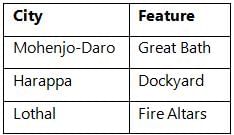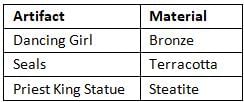Test: Old NCERT (RS Sharma): Indus Valley CIvilization - UPSC MCQ
15 Questions MCQ Test - Test: Old NCERT (RS Sharma): Indus Valley CIvilization
Consider the following statements about the Harappan Civilization:
1. The Harappan Civilization was discovered first in the modern site of Mohenjo-Daro in Sindh, Pakistan.
2. The civilization extended from Jammu in the north to the Daimabad in the south.
3. Harappa and Mohenjo-Daro were connected by the Ganges River.
How many of the statements given above are correct?
Consider the following pairs:

How many of the above pairs are correctly matched?

How many of the above pairs are correctly matched?
Consider the following statements about the end of the Harappan Civilization:
Statement -I: The decline of the Harappan Civilization can be attributed solely to the invasion by the Aryans.
Statement- II: Environmental factors, such as changes in climate and river courses, played a significant role in the decline of the Harappan Civilization.
Which one of the following is correct in respect of the above statements?
Statement- II: Environmental factors, such as changes in climate and river courses, played a significant role in the decline of the Harappan Civilization.
Consider the following statements:
- The Harappan Civilization is older than the chalcolithic cultures found in the region.
- The area covered by the Harappan Civilization was approximately 1,299,600 square kilometers.
- The Harappan Civilization used metal money for trade.
How many of the statements given above are correct?
Consider the following statements regarding the Harappan Civilization:
- The civilization had a sophisticated system of weights and measures based on the multiples of 16.
- The script of the Harappan Civilization has been fully deciphered and understood.
- More than 1500 Harappan sites have been discovered across the Indian subcontinent.
How many of the statements given above are correct?
Consider the following statements regarding the religious practices of the Harappan Civilization:
Statement -I: The Harappans worshipped a male deity who is often identified with modern Hindu god Shiva.
Statement -II: Evidence of temple structures has been found in Harappan cities, indicating a space dedicated to religious rituals.
Which one of the following is correct in respect of the above statements?
Consider the following pairs:

How many of the above pairs are correctly matched?
Consider the following statements:
- The Harappans were the earliest people to produce cotton, known to Greeks as sindon.
- The Harappan Civilization was horse-centered, with evidence of horses found in all major Harappan sites.
- Seals are considered the greatest artistic creations of the Harappan culture.
How many of the statements given above are correct?
Consider the following statements about the trade practices of the Harappan Civilization:
Statement -I: The Harappan Civilization engaged in extensive trade with Mesopotamia, as evidenced by the discovery of Harappan seals in Mesopotamia.
Statement -II: Trade within the Harappan Civilization was facilitated by the use of metal coins as currency.
Which one of the following is correct in respect of the above statements?
Consider the following statements about Harappan Civilization:
- The Great Bath of Mohenjo-Daro served a ritual purpose, likely related to religious ceremonies.
- The Harappan Civilization's urban centers like Mohenjo-Daro did not have a drainage system.
- Terracotta figurines in the Harappan culture served dual purposes: as toys and objects of worship.
How many of the statements given above are correct?
Consider the following pairs:

How many of the above pairs are correctly matched?
Consider the following statements about the agricultural practices of the Harappan Civilization:
- The Harappans were among the first to cultivate rice and cotton.
- Barley and wheat were the main crops, but rice cultivation was unknown to the Harappans.
Which one of the following is correct in respect of the above statements?
Consider the following statements regarding the town planning of the Harappan Civilization:
Statement-I: The grid system was a hallmark of Harappan urban design, with roads cutting across each other almost at right angles.
Statement-II: The Harappan cities lacked any form of drainage system, reflecting a minimal concern for public health and hygiene.
Which one of the following is correct in respect of the above statements?
Consider the following pairs:

How many of the above pairs are correctly matched?
Which of the following statements about the Indus Valley Civilization is incorrect?














